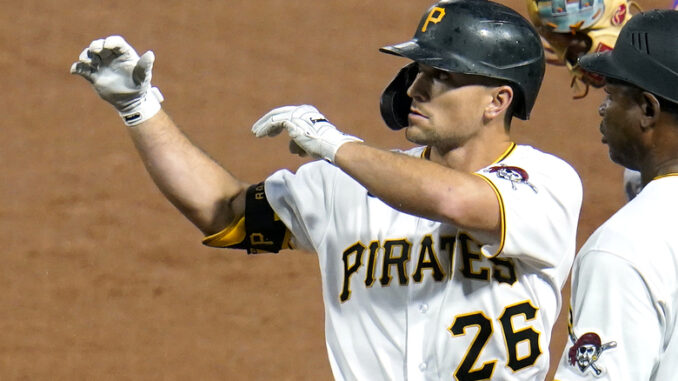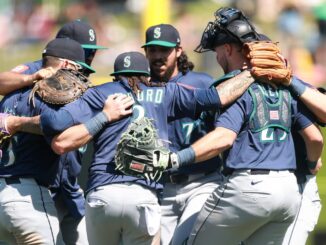
The Seattle Mariners recently acquired Adam Frazier from the San Diego Padres by trading away outfielder Corey Ray and relief pitcher Ray Kerr. The Padres were in a spot where they had four players capable of playing second base (Jake Cronenworth, Ha-Seong Kim, Jurickson Profar, and Frazier) on their 40-man roster, so someone had to be moved. The Mariners jumped at the opportunity to add last year’s NL All-Star second basemen.
In the sixth round out of Mississippi State, Adam Frazier was drafted by the Pittsburgh Pirates back in 2013. The utility infielder ended his career at MSU with a .348 batting average; scouts loved his ability to make solid contact. While his body didn’t suit playing shortstop at the professional level, Frazier slotted nicely into the second base spot while offering all three outfield positions if needed. Flash forward to 2016, where Frazier was called up. It took until the 2019 season to solidify him at second base, as the Pirates were a rebuilding team, experimenting with players in different positions on the field. The lock-in at second base certainly paid off, earning the aforementioned All-Star selection this past year.
What Are The Mariners Getting From Adam Frazier?

Currently, the Mariners hold two players on the 40-man roster that can fit into that second base position, Abraham Toro and Dylan Moore. While Moore started the season as the starting second basemen for the Mariners, the trade that acquired Abraham Toro from the Astros in exchange for Kendall Graveman and Rafael Montero put Toro into the second base spot, transforming Moore into a super-utility guy. Between Moore and Toro, the offensive numbers don’t jump off the paper. Toro produced a slash line of .252/.328/.367 with a .695 OPS, and Moore was worse off with a .181/.276/.334 slash line and an OPS of .610. I personally like Dylan Moore as a super-utility man, as he possesses a significant amount of power in his game. Toro is also only 24 years old, so he will still have time to develop.
Switching over to the newly acquired Adam Frazier, and you will notice a shift in offensive styles. While Frazier will struggle to crack ten home runs, he gives you exactly what you would want as a leadoff hitter, which is contact. Last year, Frazier produced a slash line of .305/.368/.411/ and an OPS of .779, which is substantially better than Moore and Toro. For those that are a fan of Statcast, as I am, Frazier produces some great numbers. He was fifth among all players in strikeout and whiff percentage, meaning he rarely struck out and swung and missed the ball. He was also third among all second basemen in expected batting average (.287). Expected batting average (xBA) is a formula that calculates the batting average on a hit using launch angle and exit velocity. For comparison, The Mariners at second base last year struck out the eight most, a stat that will surely swing in the opposite direction next year.
While tracking defensive metrics used to be difficult, thanks to Statcast, they can track every movement that a fielder makes. Because of this, we’re able to finally see how players can field by using their position on the field, coupled with the batted ball, wrapped into a stat called Outs Above Average (OAA for short). Abraham Toro replaced Dylan Moore as the full-time second basemen after the trade. Moore was above average at second, posting a four OAA, meaning he saved four runs above an average second baseman. Insert Toro, and you get a steep decline to -6 OAA, which means he cost the Mariners six runs with his defensive play. Adam Frazier was a slightly above average second basemen last year, posting a two OAA. While I believe Moore is the better fit at second, the overall game of Frazier far outweighs the tiny discrepancy in OAA.
How Long Do The Mariners Have Frazier?
Adam Frazier is in the final year of his contract and is estimated to be paid $7.5 million after arbitration. So immediately, I would look at other second basemen on the free-agent market or about to hit free agency the following year. Current free agent second basemen include Rougned Odor, Chris Taylor, Cesar Hernandez, Brad Miller, Donovan Solano, Niko Goodrum, Joe Panik, and Brock Holt. Out of the group, I think we can all agree that Frazier is the better option there. As for upcoming unrestricted free agents, we only have Kiké Hernández and Wilmer Flores. Kiké has proven himself a top-tier center fielder, so I’m unsure if he slots in at second base. Regardless, this puts the Mariners to possibly sign Hernández after next season if they want to go away from Frazier.

Visiting the Farm System for Other Second Basemen
If you look from within the Seattle Mariners farm system for an answer on second base, you will come up with nothing. According to MLB.com’s top prospect lists, the Mariners have no players that play at second base in the top thirty of their system. Two players could move over to second, but both play shortstop at the moment. First up is Kaden Polcovich. The 22-year-old is ranked 19th in their system and is currently on their Arkansas Travelers’ AA team. He posted a .219/.354/.395 slash line with an OPS of .749. The switch-hitting shortstop doesn’t seem to have a comfortable spot yet, splitting time between third, second, short, and even center field in the Cape Cod League. He’s not expected up until 2023, which would be when Frazier becomes a free agent. The next player would be Noelvi Marte. Mariners fans should know Marte as he was invited to Spring Training in the 2020 season as an 18-year-old. He’s ranked as their second-best prospect, behind soon-to-be major leaguer Julio Rodriguez. Marte produces an incredible amount of pop, finishing last year with a .825 OPS and 17 home runs. However, some scouts notice his defensive skill set isn’t suited for shortstop, as a move to third or second seems more likely. Marte is also estimated to come up in 2023.
Why Would the Mariners Make This Trade?
As we outlined above, the Mariners zeroed in on second base help as a priority this offseason. Their current options of Dylan Moore and Abraham Toro did not perform well enough last year to give the Mariners front office confidence that they would improve fast enough this year. The trade comes with signing Frazier to a reported $7.5 million deal for one year, which Frazier’s talent level supersedes the amount paid, compared to others currently signed. The Mariners looked at free agency but figured taking a shot on the All-Star from last year for one year was a better option. In their farm system, the Mariners don’t have a second baseman prospect in the top 30. They have two shortstops that could be converted to second basemen in Kaden Polcovich and Noelvi Marte, but they aren’t expected until 2023. Trading for Adam Frazier was the best option that the Mariners could have made in their position, and fans should be excited that the front office is making moves to get back into the postseason in 2022.



